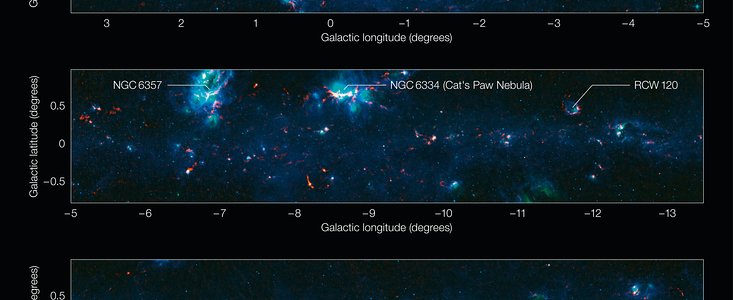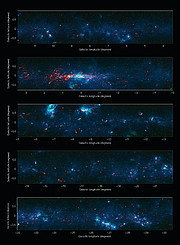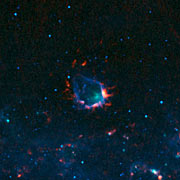Press Release
Astronomer's new guide to the galaxy: largest map of cold dust revealed
1 July 2009
Astronomers have unveiled an unprecedented new atlas of the inner regions of the Milky Way, our home galaxy, peppered with thousands of previously undiscovered dense knots of cold cosmic dust — the potential birthplaces of new stars. Made using observations from the APEX telescope in Chile, this survey is the largest map of cold dust so far, and will prove an invaluable map for observations made with the forthcoming ALMA telescope, as well as the recently launched ESA Herschel space telescope.
This new guide for astronomers, known as the APEX Telescope Large Area Survey of the Galaxy (ATLASGAL) shows the Milky Way in submillimetre-wavelength light (between infrared light and radio waves [1]). Images of the cosmos at these wavelengths are vital for studying the birthplaces of new stars and the structure of the crowded galactic core.
“ATLASGAL gives us a new look at the Milky Way. Not only will it help us investigate how massive stars form, but it will also give us an overview of the larger-scale structure of our galaxy”, said Frederic Schuller from the Max Planck Institute for Radio Astronomy, leader of the ATLASGAL team.
The area of the new submillimetre map is approximately 95 square degrees, covering a very long and narrow strip along the galactic plane two degrees wide (four times the width of the full Moon) and over 40 degrees long. The 16 000 pixel-long map was made with the LABOCA submillimetre-wave camera on the ESO-operated APEX telescope. APEX is located at an altitude of 5100 m on the arid plateau of Chajnantor in the Chilean Andes — a site that allows optimal viewing in the submillimetre range. The Universe is relatively unexplored at submillimetre wavelengths, as extremely dry atmospheric conditions and advanced detector technology are required for such observations.
The interstellar medium — the material between the stars — is composed of gas and grains of cosmic dust, rather like fine sand or soot. However, the gas is mostly hydrogen and relatively difficult to detect, so astronomers often search for these dense regions by looking for the faint heat glow of the cosmic dust grains.
Submillimetre light allows astronomers to see these dust clouds shining, even though they obscure our view of the Universe at visible light wavelengths. Accordingly, the ATLASGAL map includes the denser central regions of our galaxy, in the direction of the constellation of Sagittarius — home to a supermassive black hole (eso0846) — that are otherwise hidden behind a dark shroud of dust clouds.
The newly released map also reveals thousands of dense dust clumps, many never seen before, which mark the future birthplaces of massive stars. The clumps are typically a couple of light-years in size, and have masses of between ten and a few thousand times the mass of our Sun. In addition, ATLASGAL has captured images of beautiful filamentary structures and bubbles in the interstellar medium, blown by supernovae and the winds of bright stars.
Some striking highlights of the map include the centre of the Milky Way, the nearby massive and dense cloud of molecular gas called Sagittarius B2, and a bubble of expanding gas called RCW120, where the interstellar medium around the bubble is collapsing and forming new stars (see eso0840).
“It’s exciting to get our first look at ATLASGAL, and we will be increasing the size of the map over the next year to cover all of the galactic plane visible from the APEX site on Chajnantor, as well as combining it with infrared observations to be made by the ESA Herschel Space Observatory. We look forward to new discoveries made with these maps, which will also serve as a guide for future observations with ALMA”, said Leonardo Testi from ESO, who is a member of the ATLASGAL team and the European Project Scientist for the ALMA project.
Notes
[1] The map was constructed from individual APEX observations in radiation at 870 µm (0.87 mm) wavelength.
More information
The ATLASGAL observations are presented in a paper by Frederic Schuller et al., ATLASGAL — The APEX Telescope Large Area Survey of the Galaxy at 870 µm, published in Astronomy & Astrophysics. ATLASGAL is a collaboration between the Max Planck Institute for Radio Astronomy, the Max Planck Institute for Astronomy, ESO, and the University of Chile.
LABOCA (Large APEX Bolometer Camera), one of APEX’s major instruments, is the world’s largest bolometer camera (a "thermometer camera", or thermal camera that measures and maps the tiny changes in temperature that occur when sub-millimetre wavelength light falls on its absorbing surface; see (eso0735). LABOCA’s large field of view and high sensitivity make it an invaluable tool for imaging the “cold Universe”. LABOCA was built by the Max Planck Institute for Radio Astronomy.
The Atacama Pathfinder Experiment (APEX) telescope is a 12-metre telescope, located at 5100 m altitude on the arid plateau of Chajnantor in the Chilean Andes. APEX operates at millimetre and submillimetre wavelengths. This wavelength range is a relatively unexplored frontier in astronomy, requiring advanced detectors and an extremely high and dry observatory site, such as Chajnantor. APEX, the largest submillimetre-wave telescope operating in the southern hemisphere, is a collaboration between the Max Planck Institute for Radio Astronomy, the Onsala Space Observatory and ESO. Operation of APEX at Chajnantor is entrusted to ESO. APEX is a “pathfinder” for ALMA — it is based on a prototype antenna constructed for the ALMA project, it is located on the same plateau and will find many targets that ALMA will be able to study in extreme detail.
The Atacama Large Millimeter/submillimeter Array (ALMA), an international astronomy facility, is a partnership of Europe, North America and East Asia in cooperation with the Republic of Chile. ESO is the European partner in ALMA. ALMA, the largest astronomical project in existence, is a revolutionary telescope, comprising an array of 66 giant 12-metre and 7-metre diameter antennas observing at millimetre and submillimetre wavelengths. ALMA will start scientific observations in 2011.
ESO, the European Southern Observatory, is the foremost intergovernmental astronomy organisation in Europe and the world’s most productive astronomical observatory. It is supported by 14 countries: Austria, Belgium, Czechia, Denmark, France, Finland, Germany, Italy, the Netherlands, Portugal, Spain, Sweden, Switzerland and the United Kingdom. ESO carries out an ambitious programme focused on the design, construction and operation of powerful ground-based observing facilities enabling astronomers to make important scientific discoveries. ESO also plays a leading role in promoting and organising cooperation in astronomical research. ESO operates three unique world-class observing sites in Chile: La Silla, Paranal and Chajnantor. At Paranal, ESO operates the Very Large Telescope, the world’s most advanced visible-light astronomical observatory. ESO is the European partner of a revolutionary astronomical telescope ALMA, the largest astronomical project in existence. ESO is currently planning a 42-metre European Extremely Large optical/near-infrared Telescope, the E-ELT, which will become “the world’s biggest eye on the sky”.
Links
- The ATLASGAL paper referred to is available online
- More about APEX
- APEX handout
- Max-Planck Press Release in German
Contacts
Frederic Schuller
Max-Planck Institute for Radio Astronomy
Garching, Germany
Tel: +49 228 525 126
Email: schuller@mpifr-bonn.mpg.de
Leonardo Testi
ESO
Garching, Germany
Tel: +49 89 3200 6541
Email: ltesti@eso.org
Douglas Pierce-Price
ESO
Garching, Germany
Tel: +49 89 3200 6759
Email: dpiercep@eso.org
About the Release
| Release No.: | eso0924 |
| Legacy ID: | PR 24/09 |
| Name: | Messier 20, Milky Way Galactic Centre, NGC 6334, NGC 6357, Norma Arm, RCW120, Sagittarius B2 |
| Type: | Milky Way : Galaxy |
| Facility: | Atacama Pathfinder Experiment |
| Instruments: | LABOCA |
| Science data: | 2009A&A...504..415S |
Our use of Cookies
We use cookies that are essential for accessing our websites and using our services. We also use cookies to analyse, measure and improve our websites’ performance, to enable content sharing via social media and to display media content hosted on third-party platforms.
ESO Cookies Policy
The European Organisation for Astronomical Research in the Southern Hemisphere (ESO) is the pre-eminent intergovernmental science and technology organisation in astronomy. It carries out an ambitious programme focused on the design, construction and operation of powerful ground-based observing facilities for astronomy.
This Cookies Policy is intended to provide clarity by outlining the cookies used on the ESO public websites, their functions, the options you have for controlling them, and the ways you can contact us for additional details.
What are cookies?
Cookies are small pieces of data stored on your device by websites you visit. They serve various purposes, such as remembering login credentials and preferences and enhance your browsing experience.
Categories of cookies we use
Essential cookies (always active): These cookies are strictly necessary for the proper functioning of our website. Without these cookies, the website cannot operate correctly, and certain services, such as logging in or accessing secure areas, may not be available; because they are essential for the website’s operation, they cannot be disabled.
Functional Cookies: These cookies enhance your browsing experience by enabling additional features and personalization, such as remembering your preferences and settings. While not strictly necessary for the website to function, they improve usability and convenience; these cookies are only placed if you provide your consent.
Analytics cookies: These cookies collect information about how visitors interact with our website, such as which pages are visited most often and how users navigate the site. This data helps us improve website performance, optimize content, and enhance the user experience; these cookies are only placed if you provide your consent. We use the following analytics cookies.
Matomo Cookies:
This website uses Matomo (formerly Piwik), an open source software which enables the statistical analysis of website visits. Matomo uses cookies (text files) which are saved on your computer and which allow us to analyze how you use our website. The website user information generated by the cookies will only be saved on the servers of our IT Department. We use this information to analyze www.eso.org visits and to prepare reports on website activities. These data will not be disclosed to third parties.
On behalf of ESO, Matomo will use this information for the purpose of evaluating your use of the website, compiling reports on website activity and providing other services relating to website activity and internet usage.
Matomo cookies settings:
Additional Third-party cookies on ESO websites: some of our pages display content from external providers, e.g. YouTube.
Such third-party services are outside of ESO control and may, at any time, change their terms of service, use of cookies, etc.
YouTube: Some videos on the ESO website are embedded from ESO’s official YouTube channel. We have enabled YouTube’s privacy-enhanced mode, meaning that no cookies are set unless the user actively clicks on the video to play it. Additionally, in this mode, YouTube does not store any personally identifiable cookie data for embedded video playbacks. For more details, please refer to YouTube’s embedding videos information page.
Cookies can also be classified based on the following elements.
Regarding the domain, there are:
- First-party cookies, set by the website you are currently visiting. They are stored by the same domain that you are browsing and are used to enhance your experience on that site;
- Third-party cookies, set by a domain other than the one you are currently visiting.
As for their duration, cookies can be:
- Browser-session cookies, which are deleted when the user closes the browser;
- Stored cookies, which stay on the user's device for a predetermined period of time.
How to manage cookies
Cookie settings: You can modify your cookie choices for the ESO webpages at any time by clicking on the link Cookie settings at the bottom of any page.
In your browser: If you wish to delete cookies or instruct your browser to delete or block cookies by default, please visit the help pages of your browser:
Please be aware that if you delete or decline cookies, certain functionalities of our website may be not be available and your browsing experience may be affected.
You can set most browsers to prevent any cookies being placed on your device, but you may then have to manually adjust some preferences every time you visit a site/page. And some services and functionalities may not work properly at all (e.g. profile logging-in, shop check out).
Updates to the ESO Cookies Policy
The ESO Cookies Policy may be subject to future updates, which will be made available on this page.
Additional information
For any queries related to cookies, please contact: pdprATesoDOTorg.
As ESO public webpages are managed by our Department of Communication, your questions will be dealt with the support of the said Department.








